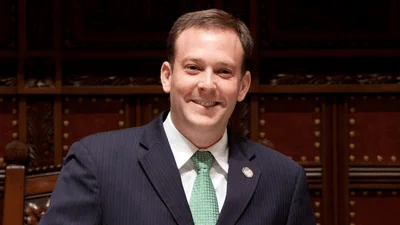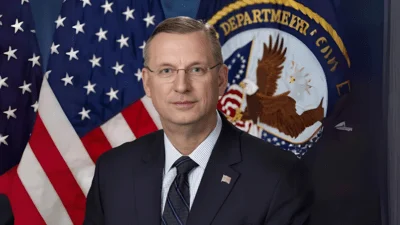U.S. Environmental Protection Agency Regional Administrator David W. Cash | epa.gov/
Today, the U.S. Environmental Protection Agency (EPA) announced $18,914,000 from President Biden's Bipartisan Infrastructure Law to address emerging contaminants, like Per- and Polyfluoroalkyl Substances (PFAS) in drinking water in New Hampshire. This investment, which is allocated to states and territories, will be made available to communities as grants through EPA's Emerging Contaminants in Small or Disadvantaged Communities (EC-SDC) Grant Program and will promote access to safe and clean water in small, rural, and disadvantaged communities while supporting local economies.
"Too many American communities, especially those that are small, rural, or underserved, are suffering from exposure to PFAS and other harmful contaminants in their drinking water," said EPA Administrator Michael Regan. "Thanks to President Biden's leadership, we are investing in America and providing billions of dollars to strengthen our nation's water infrastructure while safeguarding people's health and boosting local economies. These grants build on EPA's PFAS Strategic Roadmap and will help protect our smallest and most vulnerable communities from these persistent and dangerous chemicals."
"Today's grant announcement is one significant step in EPA's comprehensive PFAS Roadmap to support our state partners as we aggressively tackle PFAS in drinking water, protect public health, and provide critical information quickly and transparently," said EPA New England Regional Administrator and Co-Chair of EPA's Council on PFAS David W. Cash. "This funding from the Bipartisan Infrastructure Law will target resources to small or disadvantaged communities most in need of assistance and will speed up our important work reducing PFAS and other emerging contaminants in drinking water, especially in communities that are challenged by lack of capacity and funding."
"This latest allocation of federal dollars for New Hampshire demonstrates the expansive, historic reach of the bipartisan infrastructure law – today, tomorrow and months and years from now, we will continue to feel the impact of this law. I was proud to negotiate the water provisions, and specifically the elements to address PFAS, and I'm so glad to see these resources being delivered to our state. Addressing PFAS has long been a top concern for me and I'll continue to make sure this priority remains front and center in Congress so Granite Staters have peace of mind about the safety of their drinking water and environment," said U.S. Senator Jeanne Shaheen.
"Everyone deserves access to clean water, and this significant federal funding will help New Hampshire communities make real progress in addressing harmful PFAS contamination," said Senator Hassan. "I worked across the aisle with my colleagues to develop the bipartisan infrastructure law in order to address the pressing needs of our communities – including PFAS contamination -- and this funding is the latest example of how our bill is making a difference in New Hampshire. I will keep working to ensure that every household in our state has access to clean, reliable drinking water," said U.S. Senator Maggie Hassan.
"Every Granite Stater should have confidence that their drinking water is clean and safe – thanks to the Bipartisan Infrastructure Law, we are one step closer to making that a reality for communities across New Hampshire," said Congresswoman Annie Kuster. "I was proud to help secure these resources to address PFAS contamination and deliver for our state. I will continue working to turn off the tap on dangerous chemicals and hold polluters accountable," said U.S. Representative Annie Kuster.
"It's essential that all communities have access to clean and safe drinking water," said Congressman Chris Pappas. "Forever chemicals such as PFAS threaten the safety of our water, public health, and environment. This federal funding from the bipartisan infrastructure law will help us combat PFAS contamination in New Hampshire's rural and underserved communities. This is an important step in addressing PFAS contamination, and I will continue working with federal, state, and local officials to confront this issue," said U.S. Representative Chris Pappas.
The Bipartisan Infrastructure Law invests $5 billion over five years to help communities that are on the frontlines of PFAS contamination reduce PFAS in drinking water. EPA announced the funds for New Hampshire as part of an allotment of $2 billion to states and territories that can be used to prioritize infrastructure and source water treatment for pollutants, like PFAS and other emerging contaminants, and to conduct water quality testing.
EPA is also releasing the Emerging Contaminants in Small or Disadvantaged Communities Grant Implementation document. The implementation document provides states and communities with the information necessary to use this funding to address local water quality and public health challenges. These grants will enable communities to improve local water infrastructure and reduce emerging contaminants in drinking water by implementing solutions such as installing necessary treatment solutions.
Today's actions represent a significant milestone within the Biden-Harris Administration's commitments to combat PFAS pollution and safeguard drinking water, and specifically EPA's October 2021 PFAS Strategic Roadmap. Under the Roadmap, EPA is working across the agency to protect the public from the health impacts of PFAS. EPA has taken a number of actions to deliver progress on PFAS including:
- Proposing to designate two PFAS as CERCLA hazardous substances. If finalized, this will be a critical step toward increasing transparency around releases of PFAS and holding polluters accountable for cleaning up their contamination.
- Releasing drinking water health advisories. Acting in accordance with EPA's mission to protect public health and keep communities and public health authorities informed when new science becomes available, the Agency issued drinking water health advisories for four PFAS.
- Laying the foundation to enhance data on PFAS. This included an order under EPA's National PFAS Testing Strategy requiring companies to conduct PFAS testing, and nationwide sampling through the Unregulated Contaminant Monitoring Rule for 29 PFAS in public drinking water systems.
- Expanding the scientific understanding of PFAS. The Agency issued more than 30 scientific publications by EPA researchers and released EPA's PFAS Thermal Treatment Database.
- Translating the latest science into EPA's cross-agency PFAS efforts. This included updating EPA's contaminated site cleanup tables, developing new PFAS methods and conducting toxicity assessments, and issuing draft national recommended water quality criteria to protect aquatic life.
- Continuing engagement with the public. EPA's PFAS work was informed by public webinars, stakeholder meetings, Congressional testimony, and engagement with EPA's federal advisory committees.
Original source can be found here








